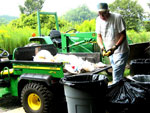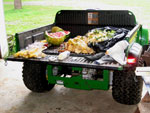Posted on Tuesday, September 12, 2006
Westminster College is a friendly, family-oriented college. This was evident on August 23 at the annual All-Campus Picnic for faculty, staff AND families. Retired employees and their families were invited too. This happened in Anderson Amphitheater on a clear evening by Brittain Lake. It was a delightful and fun-filled evening with music, camaraderie, games for children, introduction of new employees . . . and food. Food brings people together for picnics, especially this time of the year. That is good.
What happens after picnics, however, isn't always good. But this time it ended up being good! There are picnic leftovers and most of the time these are trashed -- ultimately ending up in landfills. Most people don't think about THAT. Thinking green makes people think about THAT!
So what happened at the end of a delightful evening in Andersen Amphitheater? Upon departure the plates, utensils, napkins, soda cans, water bottles, trinkets AND leftover food (sometimes scraps, sometimes untouched ears of corn) were all heaved into trash cans with plastic liners. The filled bags were NOT directly compacted and shipped to a landfill. The leftovers were NOT yet at the end of the road!
Every bag was taken to the Field Station, opened and, over the next three days, hand-sorted to separate the contents (sometimes a bit unsightly and squishy) into three other sets of plastic bags: RECYCLABLES (aluminum cans and plastic water bottles), REAL TRASH (plastic plates and utensils, plastic cups, aluminum foil, plastic wrap, latex gloves used by servers and the like) and COMPOSTABLES (food waste, uneaten food and even napkins).
Here are the numbers (scientists are always interested in numbers): 385 people attended the picnic according to Jeff Creveling, director of Sodexho Food Service and Catering; 433 pounds of trash were collected, hand sorted and weighed. From the sorting, 47 pounds of recyclables were salvaged and taken away for their reincarnation, 298 pounds of compostables were placed as "feedstocks" on the compost rows at the Field Station where (in four months) they will become good, nutrient-rich soil -- and only 88 pounds of real trash had to be compacted and sent to a landfill. Another way of looking at this is that the average Westminster picnicker on the 23rd generated 1.2 pounds of leftover "stuff"; almost 80 per cent of which had a chance for a "second life" in some form of recycling; and only 20 per cent was unrecoverable! Those are typical and good numbers.
The moral of this story is that a significant percentage of what we might thoughtlessly throw away could be used again. Sure, this takes effort. Our American, present-day life style is preoccupied with packaging and throwing away -- "out of sight, out of mind," we say. "Quick and easy solutions," not really. According to an Internet source, Americans generate trash at an astonishing rate of four pounds per day per person. That translates -- for our country -- into 600,000 tons per day or 210 million tons per year! This is almost twice as much trash per person as most other major countries. What happens to this trash? The majority is buried in landfills. Landfills do not reclaim or recycle materials. Trash will be there beyond the lifetime of anyone alive today. Landfills take up space and are one of those compromises we make as a high-tech, "use and throw-away" society. No question about it, we do need sanitary landfills. But when reusables and recyclables are tossed into trash headed for a landfill we have, effectively, lost those materials forever! We can and must do better than that!
Here are the results of 14 months of careful record-keeping for the composting project at Westminster's Field Station supported by a grant from Pennsylvania's Department of Environmental Protection: college food waste, 8.25 tons; animal cage litter, 2.4 tons; wood chips from Christmas trees, brush and community yard waste, 18 tons; shredded newsprint and white paper 1.2 tons; community food waste, 1 ton; pondweed harvested from Brittain Lake, 25 tons; New Wilmington Borough leaves, 56 tons; Little Neshannock Stables 50.5 tons and miscellaneous, 2 tons. Total compostables in 14 months was approximately 164 tons, or nearly 12 tons per month! Shrinkage, from feedstocks to finished compost, ranges from 40 to 60 per cent. This means that a minimum of 66 tons of good soil have been generated and reclaimed from what might otherwise have been considered useless waste! That's the good news. The sad news is that we have only scratched the surface of the potential for rescuing compostables in our community -- many are still being trashed or flushed. Think about THAT for your next picnic! And, since we are a generally religious community, think about THAT the next time you hear a sermon on stewardship -- or thoughtlessly toss a church service Bulletin into the wastebasket instead of shredding it for recycling or composting!
For those in the community who do not yet know about composting, come visit me at the Field Station some Monday -- composting day! And know that we accept community food and yard waste as well as shredded paper at the Field Station, 937 Fayette-New Wilmington Road! Oh yes, we also give away small amounts of finished and screened compost as potting soil -- brown gold, we call it.
Clarence Harms, Director of the Field Station

